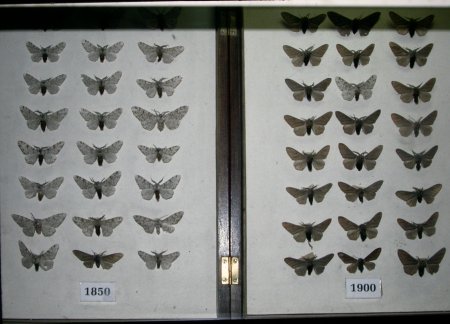Another example of changes by selection, in this case by natural selection.
Around the year 1850 these butterflies were mainly light-coloured. About
1 in 20 however belonged to the darker variant. This species had the habit
of sitting on light-colored walls and on birch bark (which is white). As
a consequence of the industrial revolution, everything became blackish from
the emitted soot. For that reason the bright butterflies lost their protection
(mimicry) and were devoured by the birds. The dark variant on the other hand
had the advantage of his colour and had a better chance to survive. The result
was that after 50 years the proportion had reversed in 1 light moth in 20
dark ones. At the moment it seems that the ratio is about 1 : 1.
N.B. this was a change inside the species: there was no new species
formed. This is an example of micro-evolution.
Know more?
Peppered
moth evolution |
Darwin had his theory ready for nearly 20 years but still he didn't dare
to come out with it, fearing the immense consequences. Yet no one else had
come up with the same idea and Darwin only spoke about it with his very close
friends Charles Lyell, the geologist, and Joseph Hooker, the botanist.
However, in 1858 he received a letter from Alfred Russell Wallace, a naturalist
in Malaysia. In the letter was an article of some pages in which the principles
of natural selection were described, exactly according to Darwin's ideas.
In fact Darwin had written his story already in 1842 in the same way. Wallace
asked Darwin to give his opinion about it and then to send it through to
Lyell for publication ...
It was a dramatic moment in Darwin's life. In the village there was a lot
of scarlet fever about and some days later his youngest son died. He was
totally broken down by these two dramas and had already decided to
give Wallace the honour of his discovery. But he got help of his friends
Lyell and ..
Know more?
Alfred Russell
Wallace |

